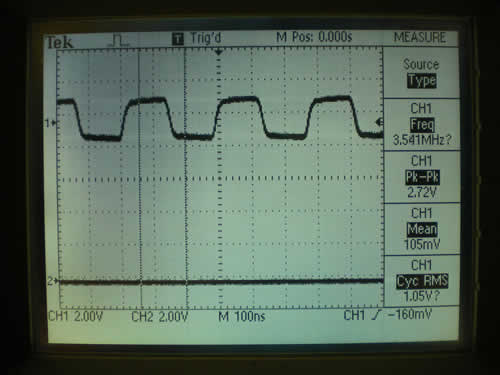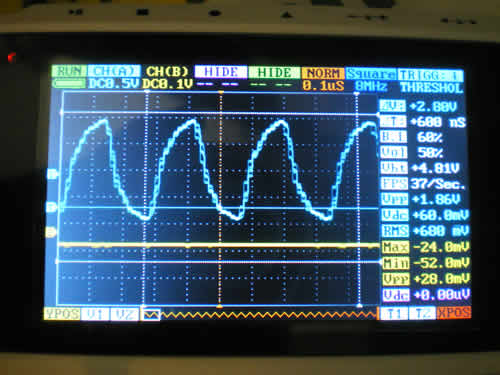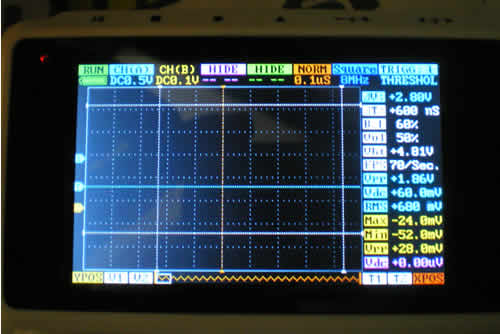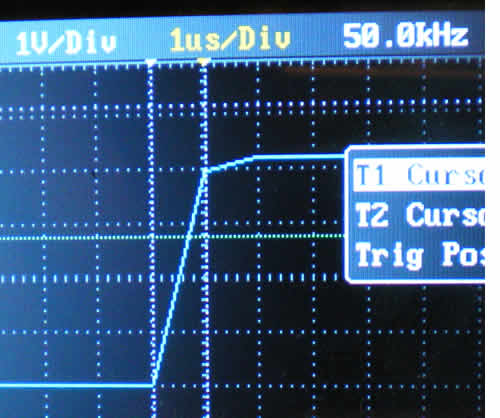Found my 1/10 problem to be the 10x setting (by mistake) on the Tektronix. 
The test conditions listed below took about 5 hours:
- Quad FW = App 2.35, Sys 1.34, FPGA 2.5, used “Normal” trigger mode for sinewaves, “Auto” trigger mode for calibration DC voltage measurements.
- Performed front-end compensation for best waveform as per factory procedures.
- Used Tektronix TDS-210 60Mhz 1GS/S scope to monitor sinewave Quad inputs.
- Used a digital multimeter to measure the DC voltages supplied to the Quad.
- Using the same DC calibration voltage as an input results in errors. This indicates that the calibration process is not working properly. When you use the same DC voltage to calibrate and then measure, you would expect consistent results, but not the case with these FW versions.
- Used the Quad Measure Vp-p function and display waveform for results measurements.
- The 50mv and 0.1v scales have bandwidth issues.
- The 0.2v scale provides consistent and flat bandwidth for the tested frequencies.

- My Heathkit IG-102 RF Generator can’t produce output voltage to properly test the remaining scales.
Conclusions:
- Throughout these tests I never felt comfortable with the Normal Trigger, however the Auto trigger was much worse. It got so bad that I would turn off the Nano for each new test because I didn’t trust that the Vpp was always updating properly. Trigger detection and associated measure updates have been measured and found lacking.
- Calibration FW and/or procedures still have issues.
- Flat bandwidth can be obtained on the 0.2v/Div scale, although the DC accuracy if different from RF accuracy.
- Need to repeat these tests using AC coupling.
Test Results:
[code]Calibrated Chnl-A 50mv/Div with 286mvDC
applied 286mvDC to input and quad = 268mvDC, same with waveform, accuracy = 94%
Tektronix 100Khz sinewave @ 156p-p mv, quad = 110p-p mv, display = 2.2 div = 110p-p mv, accuracy = 70%
Tektronix 1Mhz sinewave @ 156p-p mv, quad = 62p-p mv, display = 1.1 div = 62p-p mv, accuracy = 39%
Tektronix 2Mhz sinewave @ 156 p-p mv, quad = 42 p-p mv, display = .85 div = 42p-p mv, accuracy = 28%
Tektronix 3Mhz sinewave @ 156 p-p mv, quad = 34 p-p mv, display = .7 div = 34 p-p mv, accuracy = 22%
Tektronix 5mhz sinewave @ 152 p-p mv, quad = 28 p-p mv, display = .5 div = 28 p-p mv, accuracy = 18%
Tektronix 10Mhz sinewave @ 152 p-p mv, quad = 18 p-p mv, display = 18 p-p mv, accuracy = 12%
Calibrated Chnl-A 0.1v/Div with 559mvDC
applied 559mvDC to input and quad = 492mvDC accuracy = 88%
Tektronix 100Khz sinewave @ 156p-p mv, quad = 112p-p mv, display = 1.1 div = 112p-pmv, accuracy = 70%
Tektronix 1Mhz sinewave @ 156p-p mv, quad = 100p-p mv, display = 1 div = 100p-p mv, accuracy = 64%
Tektronix 2Mhz sinewave @ 156 p-p mv, quad = 76p-p mv, display = .8 div = 76p-p mv, accuracy = 48%
Tektronix 3Mhz sinewave @ 156 p-p mv, quad = 68p-p mv, display = .7 div = 68p-p mv, accuracy = 44%
Tektronix 5mhz sinewave @ 152 p-p mv, quad = 56p-p mv, display = .6 div = 56p-p mv, accuracy = 37%
Tektronix 10Mhz sinewave @ 156 p-p mv, quad = 36p-p mv, display = .4 div = 36p-p mv, accuracy = 23%
Calibrated Chnl-A 0.2v/Div with 1161mvDC
applied 1161mvDC to input and quad = 984mvDC accuracy = 85%
Tektronix 100Khz sinewave @ 156p-p mv, quad = 120p-p mv, display = .6 div = 120p-p mv, accuracy = 77%
Tektronix 1Mhz sinewave @ 156p-p mv, quad = 120p-p mv, display = .6 div = 120p-p mv, accuracy = 77%
Tektronix 2Mhz sinewave @ 156 p-p mv, quad = 120p-p mv, display = .6 div = 120p-p mv, accuracy = 77%
Tektronix 3Mhz sinewave @ 156p-p mv, quad = 120p-p mv, display = .6 div = 120p-p mv, accuracy = 77%
Tektronix 5mhz sinewave @ 156p-p mv, quad = 120p-p mv, display = .6 div = 120p-p mv, accuracy = 77%
Tektronix 10Mhz sinewave @ 156p-p mv, quad = 120p-p mv, display = .6 div = 120p-p mv, accuracy = 77%
[/code]









